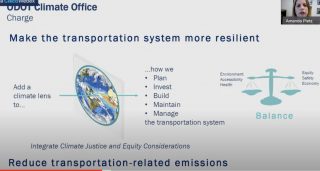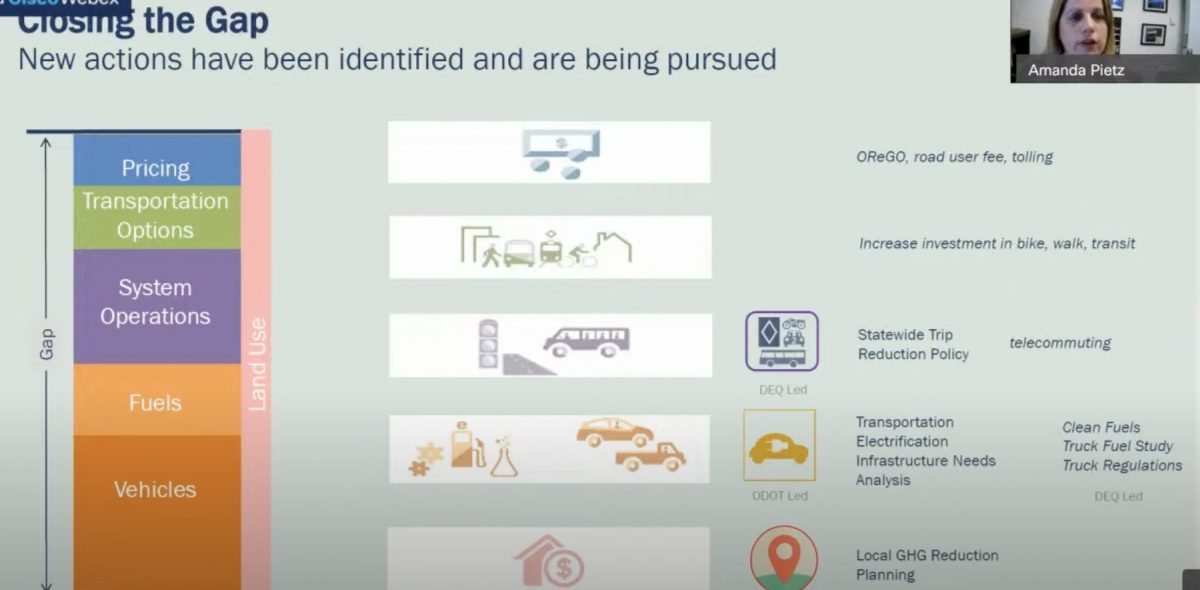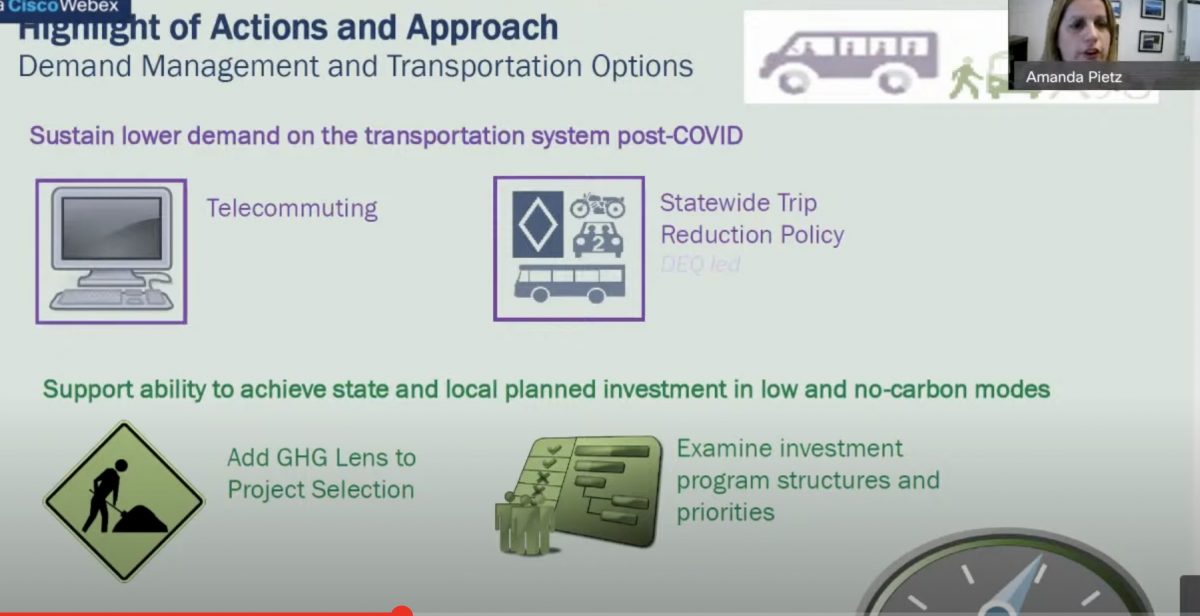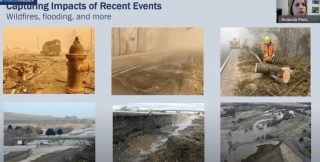
(Source: ODOT Climate Office)
“We have a significant gap between where we are likely to go and where we need to go.”
— Amanda Pietz, ODOT Climate Office
The Oregon Department of Transportation isn’t moving fast enough to meet greenhouse gas (GHG) reduction goals. That’s according to ODOT Climate Office Director Amanda Pietz, who served up the bad news at a meeting of the Oregon Transportation Commission yesterday.
Earlier this summer Governor Kate Brown issued an executive order to reduce emissions to at least 45% below 1990 levels by 2035 and to at least 80% below 1990 emissions by 2050.
During a presentation to the OTC that included a chart on a slide with the word “Gap” between current trends and Oregon’s reduction goals, Pietz said, “We’ve developed a statewide transportation options program, we were able to secure multimodal funding thanks to the legislature — so there’s some positive in there. But those are outweighed unfortunately by the negative people driving more, people holding on to their cars longer, and a lot of fuel inefficient cars on the road. So that’s resulted in an increase in emissions. So, we’re moving in the complete wrong direction… We have a significant gap between where we are likely to go and where we need to go.”
Meredith Connolly, Oregon director for nonprofit advocacy group Climate Solutions, was encouraged to hear this rare bit of candor from an ODOT staffer. “The first step to fixing a problem is admitting you have one,” Connolly shared with BikePortland. “So it’s encouraging to hear an admission from within ODOT’s ranks that they need to step it up on climate. Now we need to see them actually do something about it!”
To that end, Pietz presented OTC members with more about how ODOT plans to close the emissions gap. Or as she put it yesterday: “We’re looking to help turn the ODOT ship… integrating climate means shifting the heart of our practices.”

ODOT’s Climate Office was formed this past spring and currently has seven full-time staffers. As a first order of business, Pietz said they’re adding a “climate lens” to everything ODOT does, including how they invest, build, and manage our transportation system.
But she added a caveat: “I’m purposeful in adding the word ‘lens’ to that, because climate will be one factor among many to influence our decisions, and will need to be balanced for safety, equity and other key outcomes.”
Advertisement
The most promising use of this lens will come as ODOT — for the first time ever — will apply it to all projects in its Statewide Transportation Improvement Program (STIP, the list projects must be on before they get funded and built). The 2024-2027 STIP process is just getting underway and it gives ODOT a golden opportunity to make good on climate promises.
Beyond the STIP, the work of the Climate Office has three main parts: mitigation (reducing GHG emissions from the transportation sector), adaptation (creating a system more resilient to floods, fires, evacuation needs, coastal erosion, and so on), and sustainability (initiatives like solar highways, which Pietz said have fallen off the priority list due to other more pressing needs). Pietz said they see the most immediate potential in switching to electric vehicles and encouraging the use of cleaner fuels and she made a point to say EVs stand for more than just cars. “Think of micromobility options like electric scooters, electric bikes, but also on the heavy side like freight and buses.”



ODOT also sees a silver lining in the Covid-19 crisis. Pietz pointed out that the viability of telecommuting has “been proven” thanks to the pandemic and that the reduction in trips is a positive outcome. “We as an agency really want to support those kind of transitions and we also want to capture the benefits of [telecommuting].”

One transition that’s much less positive for ODOT (and everyone else) is how we’ve quickly gone from climate change prevention, to climate change adaptation. In coming years we’ll be hearing much more from ODOT about their role in dealing with climate change related disasters like fires, floods, and rising sea levels. Today, ODOT Director Kris Strickler will go in front of the State Emergency Board to support a $50 million wildfire cleanup project the agency will carry out. The work would go beyond the right-of-way and represents a new direction for ODOT if we assume “climate fires” (which is how new OTC member Maurice Henderson referred to them in the meeting yesterday) will become the future norm. It also which sets up a conflict of interest because ODOT’s failure to reduce GHG emissions and their car-centric planning are directly related to the intensity and of the recent fires and Strickler himself believes widening highways leads to lower emissions.
To reach climate goals ODOT must do more to reduce vehicle miles traveled (VMT). A statewide analysis by Climate Solutions published last month (PDF) found that the best scenario combines reduced VMT with electrification.
Investing more in “transportation options” (not driving) is a part of ODOT’s strategy (see chart), but it remains to be seen whether they can steer their ship far enough away from the sirens of auto capacity to move the needle for bicycling, transit, and micromobility.
Pietz is optimistic: “The Governor’s executive order was a recognition that we need to get back on track. The good news is that we can catch up. That gap is achievable.”
— Jonathan Maus: (503) 706-8804, @jonathan_maus on Twitter and jonathan@bikeportland.org
— Get our headlines delivered to your inbox.
— Support this independent community media outlet with a one-time contribution or monthly subscription.

